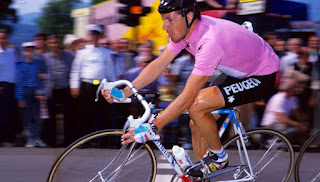Two decades ago, I was living on Bergen Street, on the northern side of Park Slope, Brooklyn. I was midway between Fifth Avenue, then one of the area's main shopping strips, and Flatbush Avenue, one of Brooklyn's main throughfares.
The latter street was often called, in a grim joke, "The Mason-Dixon Line." The difference between the two sides of the Aveune was literally black and white. I ended up on the white side. Some time after I moved there, I realized that all of the apartments the agent with whom I'd dealt showed me were on the side of Flatbush where I lived.
The local precinct house was just on the other side. I often heard stories about how differently each side was policed. It was during that time I heard an expression that may be familiar to you: Driving While Black, or DWB for short.
Of course, the phenomenon was not limited to that neighoborhood--or, for that matter, to any particular American city, or to the US. It's also not surprising to realize that there's a two-wheeled equivalent: BWB, or Biking While Black.
Yesterday, an article by Chicago Tribune reporter Mary Wisniewski revealed that of the ten community areas with the most bike tickets from 2008 to September 2016, not a single one has a white majority of residents. Seven of those neighborhoods have an African-American majority, while Latinos are the majority in the other three.
What must be most galling, particularly to Black and Hispanic cyclists in the Windy City, is that the neighborhoods with the greatest numbers of cyclists are mainly-white enclaves such as West Town and Lincoln Park, whose cyclists didn't come anywhere to getting as many summonses as those in such communities as Austin and North Lawndale.
But African-American cyclists are bearing the greatest burden of constabular harassment, according to Wisniewski.
"As Chicago police ramp up their ticketing of cyclists," she writes, "more than twice as many citations are being written in African-American communities than in white or Latino areas."
Some law enforcement officers and commanders repeat an argument I have heard before and is condescending or simply insulting, depending on your point of view. In essence, they say people in low income (which usually means African or Hispanic) communities are less educated and therefore more ignorant of the rules of the road. But others, including cycling advocates, point out there are simply more cops on the streets because of their higher crime rates, so there are more opportunities to stop cyclists in such neighborhoods.
Whatever the explanation, such tactics can only worsen relations between the police and non-white residents in a city where, by many accounts, such relations are worse than in most other cities.
And don't get me started on relations between cops and cyclists--or trans women!
The latter street was often called, in a grim joke, "The Mason-Dixon Line." The difference between the two sides of the Aveune was literally black and white. I ended up on the white side. Some time after I moved there, I realized that all of the apartments the agent with whom I'd dealt showed me were on the side of Flatbush where I lived.
The local precinct house was just on the other side. I often heard stories about how differently each side was policed. It was during that time I heard an expression that may be familiar to you: Driving While Black, or DWB for short.
Of course, the phenomenon was not limited to that neighoborhood--or, for that matter, to any particular American city, or to the US. It's also not surprising to realize that there's a two-wheeled equivalent: BWB, or Biking While Black.
 |
| From phmelody.com |
Yesterday, an article by Chicago Tribune reporter Mary Wisniewski revealed that of the ten community areas with the most bike tickets from 2008 to September 2016, not a single one has a white majority of residents. Seven of those neighborhoods have an African-American majority, while Latinos are the majority in the other three.
What must be most galling, particularly to Black and Hispanic cyclists in the Windy City, is that the neighborhoods with the greatest numbers of cyclists are mainly-white enclaves such as West Town and Lincoln Park, whose cyclists didn't come anywhere to getting as many summonses as those in such communities as Austin and North Lawndale.
But African-American cyclists are bearing the greatest burden of constabular harassment, according to Wisniewski.
"As Chicago police ramp up their ticketing of cyclists," she writes, "more than twice as many citations are being written in African-American communities than in white or Latino areas."
Some law enforcement officers and commanders repeat an argument I have heard before and is condescending or simply insulting, depending on your point of view. In essence, they say people in low income (which usually means African or Hispanic) communities are less educated and therefore more ignorant of the rules of the road. But others, including cycling advocates, point out there are simply more cops on the streets because of their higher crime rates, so there are more opportunities to stop cyclists in such neighborhoods.
Whatever the explanation, such tactics can only worsen relations between the police and non-white residents in a city where, by many accounts, such relations are worse than in most other cities.
And don't get me started on relations between cops and cyclists--or trans women!




























